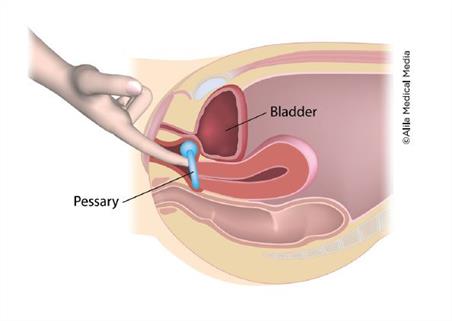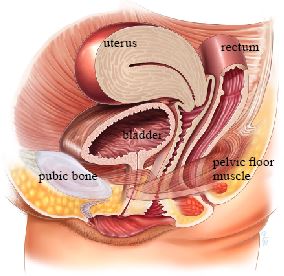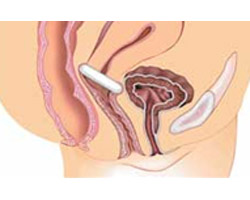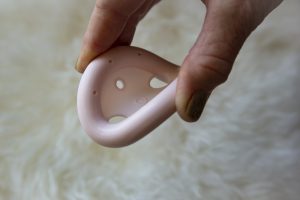how long should you wear a pessary
Only 23 of 167 14 continued with pessary use at the study endpoint November 2008. Estrace contains 01 mg estradiol per gram of cream.

How Long Should I Leave A Pessary In Place
Bioteque recommends daily cleaning but also says its fine to leave the pessary in place for 4 to 12 weeks.

. They recruited volunteers with pelvic floor prolapse and randomly assigned 128 to do pelvic floor exercises daily and 128 to wear a pessary and do the exercises. Pessaries are a safe long-term treatment for prolapse but they do need to be changed every three to six months. You may be able to take out clean and reinsert your pessary yourself.
This depends on the kind of pessary you are prescribed. In cases where the pessary cannot be removed by the patient follow-up visits usually occur every two to three months. Milex does not address home care but recommends a followup visit with your health care provider every 4 to 6 weeks noting that the schedule can be adjusted based on patient and physician preference.
At the other extreme some women leave a pessary in place for weeks or months. Pessaries are a safe long-term treatment for prolapse but they do need to be changed every three to six months. Patients who are noncompliant or unlikely to follow up should not be fitted for a pessary.
Tips for Using a Pessary. This is to make sure the pessary does not fall out and that you can pass urine with the pessary in place. If an ulcer has occurred a person should not wear their pessary until it has healed.
If a pessary is fitted correctly the healthcare providers finger should pass easily between the pessary and the vaginal wall. Some women will be able to do this at home themselves but others will need to go to a hospital or a clinic to have this done for them. If youre suitable for pessary fitting you can wear a pessary for as long as you choose provided you take it out for cleaning and to check that there is no erosion occurring in the walls of your vagina.
Many patients leave the office with small but painful abrasions of the vaginal introitus. You should use a mild soap with water rinse and dry it completely and reinsert it into the vagina the next morning. Active infections of the pelvis or vagina such as vaginitis or pelvic inflammatory disease preclude the use of a pessary until the infection has been resolved.
Of those who discontinued the median duration was 14 years range 0111 years. The largest size you can wear comfortably is usually the best choice. Most infections occur when a pessary is left in for too long are kept for longer than five years or are not cleaned properly between uses.
They can be cleaned with simple soap and water. During the visit the pessary will be removed and cleaned. We may also fit a different sized pessary if it falls out or you cant pass urine with it in place.
Contraindications of using a pessary. You should not be able to feel a pessary if it is correctly placed. You can wear most pessaries for many days before taking them out to clean.
There are few contraindications to the use of a pessary. You can use any kind of antibacterial soap to clean it. Follow your doctors advice on how long you can wear your pessary before it needs to be cleaned.
Follow your doctors advice on inserting the pessary. If you clean your pessary wash it with mild soap and water. Participants will be provided with the medication in prepackaged 05cc syringe.
The vagina will be examined to make sure the pessary is not scraping or bruising the skin. If you are unable to easily remove and insert the pessary on your own you should go to the doctor every three months for professional examination and cleansing. Some women will be able to do this at home themselves but others will need to go to a hospital or a clinic to have this done for them.
People should go to a doctor every 36 months to check for ulcers. In comparison a type of pessary used for women with advanced degrees of vaginal prolapse called cube pessary should be removed every night. The recommended dosing is 2-4 grams daily for 1-2 weeks with a gradual reduction to half the initial dose over 1-2 weeks and then 1 gram 1-3 times weekly for maintenance.
Some women wear a pessary only occasionally or wear it during the day but take it out every night. Interquartile range 0536 years. You might see a little spotting of blood when you remove or insert the pessary.
Store the pessary in a clean safe area until you are ready to replace it. It is OK to keep it in for a longer period of time but never more than 3 months at a time. If you care for your own pessary we will usually have you come to the office for an examination initially in 2 weeks and then in 3 months.
The median duration of use was 7 years interquartile range 69 years. Know more about it here. Even in the most experienced hands pessary removal in the office may be difficult and painful.
How long can I use a pessary for. Most women find they are able to successfully use a pessary for two years or more without requiring surgery for their condition. Talk to your doctor if this happens.
The women also completed two questionnairesone designed to evaluate their symptoms the other to evaluate their quality of lifeat the beginning and end of the study. As long as its just spotting for a day or two do not worry. You may be able to remove and clean it yourself or your doctor may want to do this during an office visit.
However other types such as cube pessary must be removed every night. Your doctor may want you to come into the office so he or she can do it. Shop Save Today.
Its important that you follow your doctors instructions about caring for your pessary. Benefits and side effects of using a pessary. You do not need anything specific.
Youll need to check with your doctor or Physio who can fit your pessary regarding your suitability. Depending on the type of pessary prescribed you should be able to leave it in for as long as four to six months. There are sometimes.
If you experience significant pain or discomfort the pessary may be too large or small and require replacement with a different size. Pessaries are designed to stay in place for weeks on end allowing fluids to flow around them even your menstrual flow but frequent removal and reinsertion is perfectly safe and acceptable. For the great majority of women with prolapse pessaries equate to a commitment to lifelong office visits every 2 to 3 months.
Most vaginal pessaries can be left in for as long as four to six months or unless told otherwise by your healthcare provider. Age is not an issue. Ad Browse Our Huge Selection Of Discount Pessary Ring Products.
Follow-up visits should take place every six to 12 months. Most vaginal pessaries can be left in for as long as four to six months or unless told otherwise by your healthcare provider. A properly fitted pessary should not cause any pain - if it does then we will need to change the size.

Vaginal Pessary For Pelvic Organ Prolapse Your Pelvic Floor

Pessary Fitting For Prolapse How To Know If Your Pessary Fits

Vaginal Pessaries Brazosport Women S Health

Practical Use Of The Pessary American Family Physician

Practical Use Of The Pessary American Family Physician

Pessaries One Easy Way To Manage Prolapse Foundation For Female Health Awareness

Pessaries One Easy Way To Manage Prolapse Foundation For Female Health Awareness

Herman Wallace Pelvic Rehabilitation Continuing Education The Pelvic Rehab Report Pessary Use And Defecatory Dysfunction
/Pessaries-55f53371cf50419a90dd8b70eff78bc1.jpg)
Vaginal Pessary Uses Benefits Side Effects Risks

Vaginal Pessaries Comprehensive Services For Women At Chi St Vincent

Pessaries For Pop And Sui Their Fitting Care And Effectiveness In Various Disorders Mdedge Obgyn

Practical Use Of The Pessary American Family Physician

Bladder Support Pessaries How Do They Work Supported Mums

Pessaries For Prolapse And Urinary Incontinence Proactive Pelvic Health




